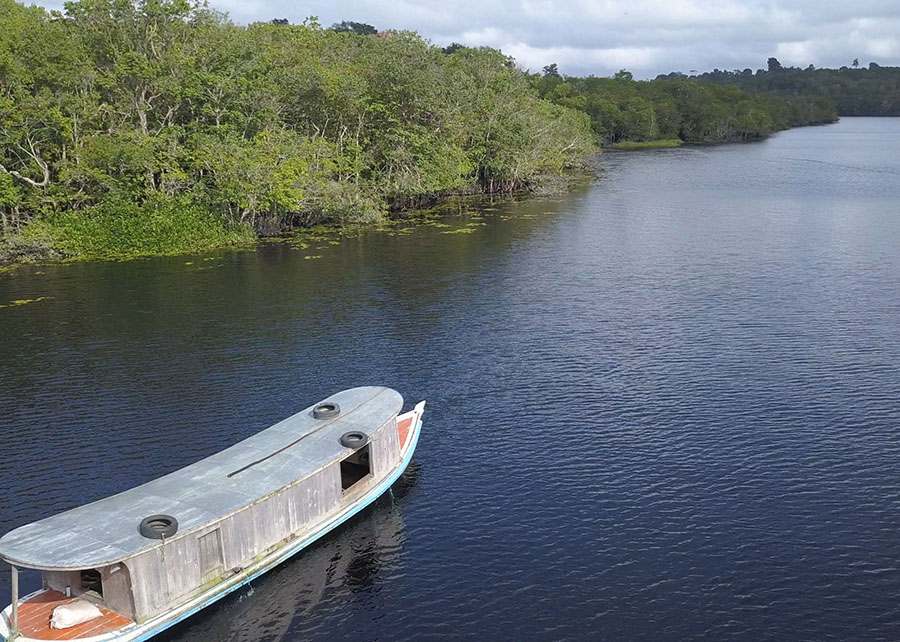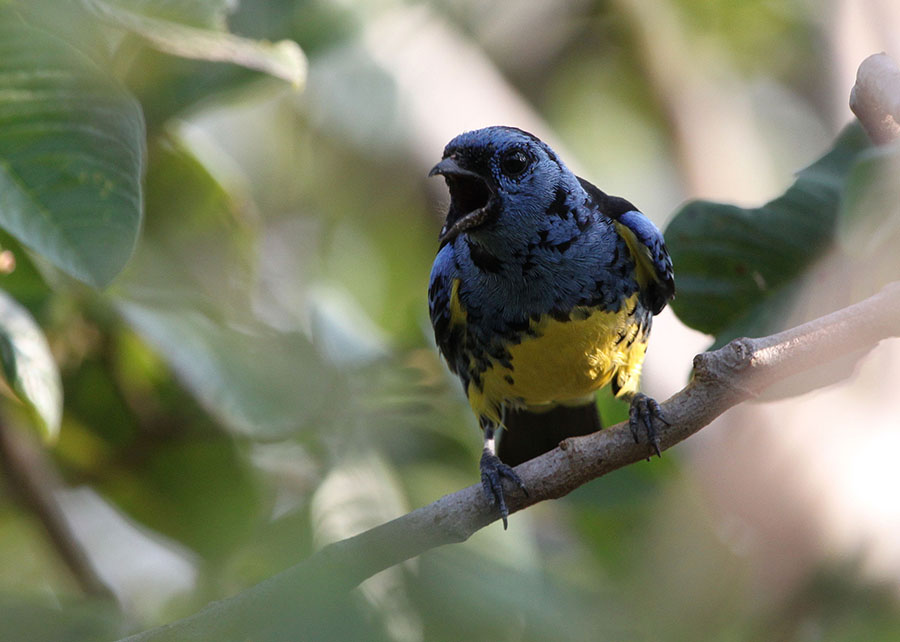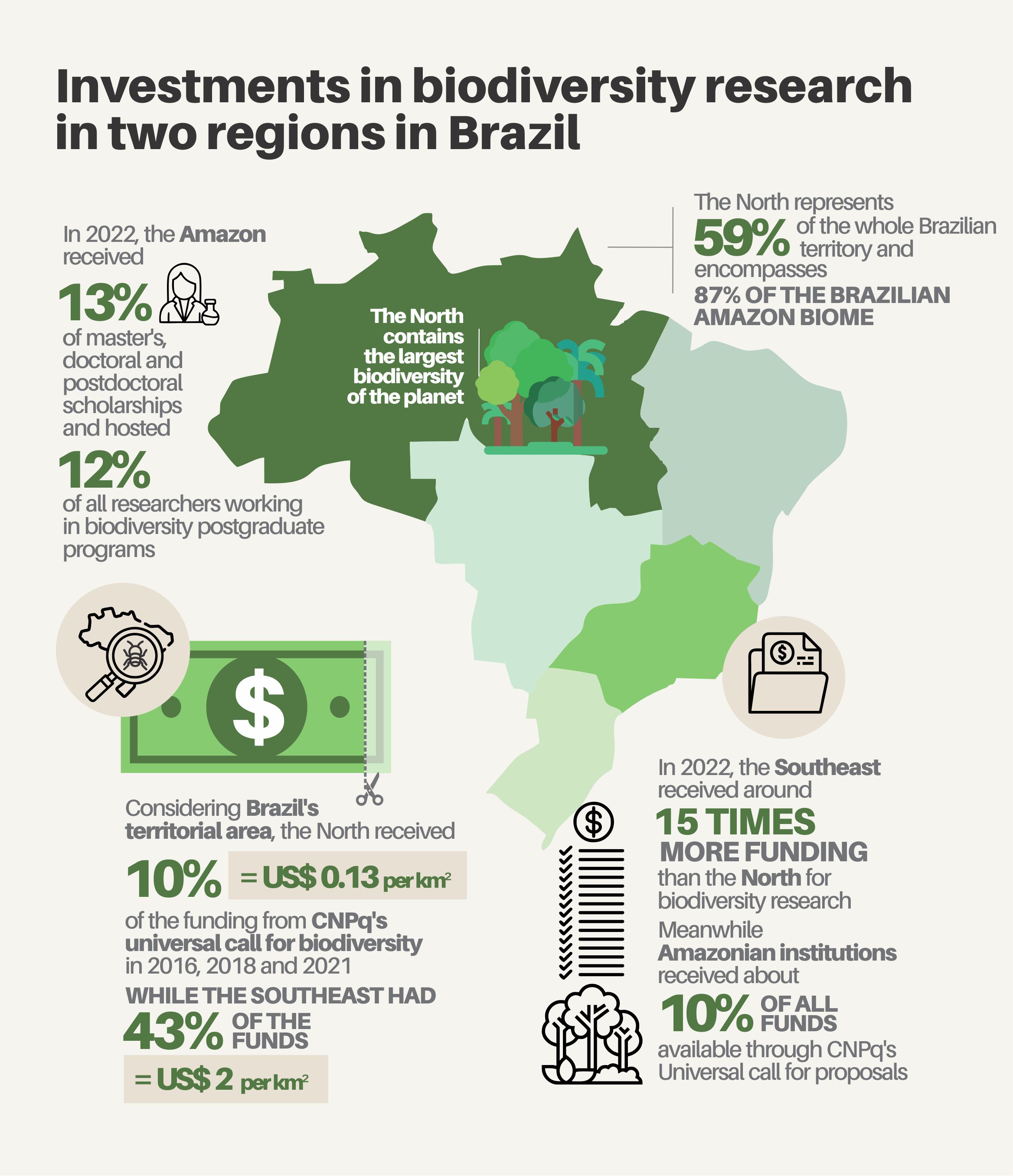The Amazon receives less investment in biodiversity research than other regions of Brazil
The Amazon receives less investment in biodiversity research than other regions of Brazil
Photo: Jaime Souza_André Mardock

Scientists assert that the Amazon's gigantic biodiversity needs more investment to be known and conserved
|
Although the Brazilian Amazon is the most biodiverse region in the world and home to the largest tropical rainforest on the planet, investments in research on the biodiversity in the biome are disproportionately low compared to other regions of Brazil. The assertion is from a study carried out by researchers from Brazilian and foreign institutions, published in the journal Perspectives in Ecology and Conservation.
The paper, entitled "Brazilian public funding for biodiversity research in the Amazon", shows that Amazonian institutions received approximately 10% of all federal budget spent on research projects and about 23% of all funds destined to support long-term ecological studies. And In 2022, the Amazon received 13% of master's, doctoral and postdoctoral scholarships and hosted 12% of all researchers working in postgraduate programs in biodiversity.
The study analyzed funding for biodiversity research projects, offer of research grants, and training of researchers through graduate programs between 2016 and 2022. The sources analyzed were the two main federal government calls for funding for research in Brazil: the Long-Term Ecological Research Program (Peld, from the acronym in Portuguese) and the Universal call for proposals, both by the National Council of Scientific and Technological Development (CNPq);and the largest federal agency for the training of human resources, the Coordination for the Improvement of Higher Education Personnel (Capes).
 "The aim of this study was to analyze the distribution of funding for biodiversity research and to show how knowledge about the Amazon has been underfunded in comparison with other regions of the country. The study also points pathways and makes recommendations to reduce such inequality," says Joice Ferreira, a researcher at Embrapa Eastern Amazon and one of the authors of the paper.
"The aim of this study was to analyze the distribution of funding for biodiversity research and to show how knowledge about the Amazon has been underfunded in comparison with other regions of the country. The study also points pathways and makes recommendations to reduce such inequality," says Joice Ferreira, a researcher at Embrapa Eastern Amazon and one of the authors of the paper.
She reports that research on biodiversity is important to understand how species are distributed in the territory and which regions are most ecologically sensitive within each biome. “Long-term ecological studies monitor the changes that each biome has been going through, caused both by natural events and by human action,” adds Lis Stegmann, a visiting researcher at Embrapa during the study and first author of the paper.
The study stems from a research network in the scope of the Synergize project, which is part of the Brazilian Synthesis Centre on Biodiversity and Ecosystem Services (SinBiose), by the National Council of Scientific and Technological Development (CNPq), involving researchers from 12 national and international institutions and is coordinated by Embrapa and the University of Bristol, in the United Kingdom.
High importance and little investment
According to the scientist, the analysis was based on data made available by federal agencies and the Transparency Portal. The distribution of funding for projects and scholarships in the different regions were analyzed based on population density and territorial extension. "We analyzed both the absolute figures and the numbers in contrast with the population of each region and the size of their respective territories. This is because we believe that these metrics should be conducive to policies and to the allocation of public funding," Stegmann observes.
In absolute numbers, the Brazilian North and Midwest regions have the worst indicators. According to the study, the North received about 10% of the funding made available through CNPq's Universal call for proposals between 2016 and 2022, and 22% of the funding available through CNPq's 2020 PELD for long-term research. The South and Southeast regions combined had 50% of those funds during the period that was analyzed.
The analysis in terms of population shows that the North region would have one grant or scholarship for every 34,000 people, while the Southeast region had a ratio of one per 58,000 inhabitants. In addition, the North has 1.5 more researchers working in biodiversity programs than the Southeast. But the scenario is radically reversed when the distribution of funding is analyzed in the light of territorial extension.
“Although per capita investment in research in the Amazon is higher than or equivalent to that available in the most economically developed regions of Brazil, the distribution of funding per area is highly unequal,” Stegmann affirms.
While the Southeast region received about US$2 per square kilometer (km²) to fund biodiversity research through the Universal call, the North region received US$0.13. This shows that about 90% of federal funding for biodiversity research are outside the region that hosts the largest tropical rainforest on the planet. And something that is more important than the area to be researched is the gigantic yet unknown biodiversity that the biome harbors, which needs much more scientific investment so that such natural riches are known and preserved, the scientists assert.
The biomeThe North region represents 59% of the entire Brazilian territory and contains 87% of the entire Brazilian Amazon. The biome is home to 16,000 tree species, 2,700 fish species, 1,400 bird species, over 80 billion tons of carbon, as well as the largest ratio of protected areas and indigenous lands. |
"We would like to draw attention to the contradiction between the importance of the region and what it receives in terms of investment. It is essential to develop a strategic plan for fund allocation that makes research be in line with the socio-environmental relevance of the Amazon for Brazil and the planet," the researcher Joice Ferreira says.
 Intra-Amazonian inequalities
Intra-Amazonian inequalities
The group of researchers also observed the internal distribution of funding for biodiversity research in the Brazilian North and found that about 90% of all subsidies and research grants available for the region are concentrated in the capitals Belém, PA, and Manaus, AM. In absolute numbers, these two cities detain 90% of Capes' research scholarships and 92% of the funding available through CNPq's Universal call for proposals.
Another study published by the research group had previously asserted that research funding and structures in the North are concentrated in the capitals. "Despite the efforts to make federal universities and institutes more present within the country, campuses in the countryside and research teams outside the largest capitals have not been able to access or raise the funding that is available in federal public calls," the scientist says.
Lis Stegmann highlights the efforts of state research foundations in the North region, with emphasis on the Amazonian Research Support Foundation (FAPESPA), d, in Pará state, and the Amazonas State Research Support Foundation (FAPEAM), which fund local projects, but she reports that the budget they allocate is still insufficient to change the inequality between the region and the other Brazilian ones. "While FAPEAM's budget in 2022 was about R$140 million, the budget for FAPESPA, which is the counterpart research foundation in São Paulo state, in the same year, was about R$2 billion", the researcher exemplifies.
The group also observed the number of active professionals in two important research institutions in the Amazon: the Emílio Goeldi Museum (MPEG)and the National Amazon Research Institute (Inpa).
"We analyzed the years that active researchers in those two institutions joined them. The results showed that almost 80% of INPA's active researchers and 40% of the Goeldi Museum's active researchers could already retire from 2024 on, which may point to a scenario of research discontinuity and of dismantlement of the largest research institutes in the Amazon," she warns.
Infographic by: Giselle Aragão
International alliances, decentralization of funding and exclusive fund
The paper makes recommendations to the government, such as the establishment of a fund for biodiversity research focused specifically on the Amazon. "It is necessary to consider that the Amazon is the most diverse biome in the world that houses the largest remaining tropical rainforest, and it is one of the major centers of climate regulation on the planet. A structured, long-term and continuous policy for research on biodiversity is needed”, Stegmann underscores.
Another recommendation is the decentralization of funding, with knowledge transfer and articulation of research networks between the capitals and the towns in the countryside of the region. "It is important that the calls for proposals have different metrics and value the regional outlook. Research should be evaluated according to local demands," she said.
And the third recommendation is strengthening transnational cooperation and alliances. “Ecological research in the Amazon is usually expensive because it requires complex logistics. Large-scale projects usually only happen due to international cooperation, such as the Large Scale Program of the Biosphere-Atmosphere in the Amazon (LBA), the Amazon Tall Tower Observatory (ATTO), among others, " she exemplifies.
The scientists argue that an increase in research funding for the Amazon region requires a distinct input from federal agencies and integration between Amazonian programs and international funds.
Ana Laura Lima (MTb 1.268/PA)
Embrapa Eastern Amazon
Press inquiries
amazonia.oriental-imprensa@embrapa.br
Phone number: +55 91 3204-1060
Translation: Mariana Medeiros (13044/DF)
Superintendency of Communications
Further information on the topic
Citizen Attention Service (SAC)
www.embrapa.br/contact-us/sac/


